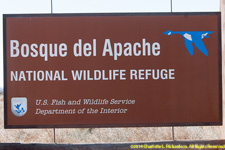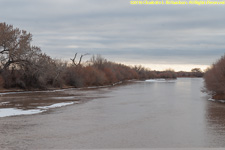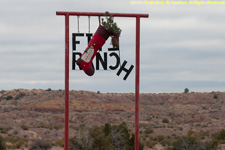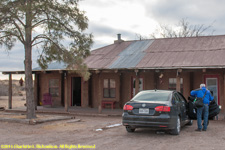



Bosque del Apache ("Forest of the Apache") National Wildlife Refuge is located in the Middle Rio Grande Valley, west of the river. Estabished in 1939, the reserve protects important wintering habitat along the Rio Grande for waterfowl, particularly sandhill cranes. The altitude here is about 4500', so the winter temperature can vary 30 degrees or more between dawn and noon.
Photographing at Bosque del Apache: the closest places to stay are bed and breakfast places like Fite Ranch, or motels farther north in Socorro. Huge lenses are the norm here during winter months when the reserve is very popular with bird photographers.
Scenery
The morning sunrise fly-out of snow geese and cranes attracts crowds of photographers.
Sandhill cranes (Grus canadensis): winter migrants.
Geese:
Canada Geese (Branta canadensis): common, especially in the winter.
Snow and Ross's Geese: Most snow geese (Chen caerulescens) are white, with black primary feathers and pink legs and bill. They can be distinguished from the smaller Ross's geese (Chen rossi) by their larger size and black "lips". In the third image here, on the left a Ross's goose is standing in front of a snow goose. "Blue" geese, like the one in the last image, have a white head and upper neck, a mostly grey body though the belly may be white, and black-tipped wings.
Hawks, eagles, and kestrels: Note that we are not raptor experts. We may have misidentified some of these birds, especially Cooper's and sharp-shinned hawks. Contact us by email if you find errors.
Northern Harrier Hawks (Circus cyaneus): the female is brown while the male is grey. Both sexes have an owl-like face. They like to roost on the ground or on low foliage rather than in tall trees.
American kestrels (Falco sparverius): small falcon.
Red-tailed hawks (Buteo jamaicensis): most common hawk. Immature birds are fairly tolerant of people (at least of people in cars).
Cooper's Hawks (Accipiter cooperii): found in cottonwood woodlands.
Sharp-shinned hawk (Accipiter striatus): smaller than a Cooper's hawk.
Bald eagles (Haliaeetus leucicephalus): common in the bosque during the winter, when they feed on old or sick geese.
Sparrows
Red-winged (Agelaius phoeniceus) and Yellow-headed (Xanthocephslus xanthocephalus) Blackbirds congregate in huge flocks that move like swarms.
Greater Roadrunners (Geococcyx californianus): common, like to sun themselves along the side of the road, fluffing up their feathers to allow the sun to warm the dark down feathers on their backs. When the bird raises its crest, you can see the blue, white, and red strip behind its eye. Roadrunners can fly but usually run instead, and are fairly tolerant of people in vehicles.
Killdeers (Charadrius vociferus): relatively uncommon in winter.
Ducks:
Northern pintails (Anas acuta): a dabbling duck, the pintail forages by tipping over in the water with its tail sticking out.
Northern shoveler (Anas clypeata): has a long spade-shaped bill and is mainly a surface-feeding duck.
Green-winged teal (Anas carolinensis): smallest North American dabbling duck.
Mallard (Anas platyrhynchos): common.
Bufflehead (Bucephala albeola): small diving duck.
Ruddy ducks (winter plumage) (Oxyura jamaicensis): a diving duck.
Redhead (Aythya americana): diving and dabbling duck.
American Coots (Fulica americana): ducklike water birds.
Gambel's Quail (Callipepla gambelii): found in open areas with some ground cover.
Great Blue Herons (Ardea herodias): common along the irrigation canals. They tend to remain very still and are human-tolerant.
Crows (Corvus brachyrhynchos) and Ravens (Corvus corax)
Say's Phoebes (Sayornis saya): small flycatchers.
Mourning Dove (Zenaida macroura)
Dark-eyed Juncos (Junco hyemalis)
Western Meadowlark (Sturnella neglecta)
Spotted Towhee (Pipilo maculatus)
Tundra swan (Cygnus columbianus)
Coyotes (Canis latrans)
Mule Deer (Odocoileus hemionus)
The evening fly-in
©2015, 2016 Mermaid Underwater Photographic. All Rights Reserved.
Contact us at mermaid@underwater.org.
Last modified 24 June 2016